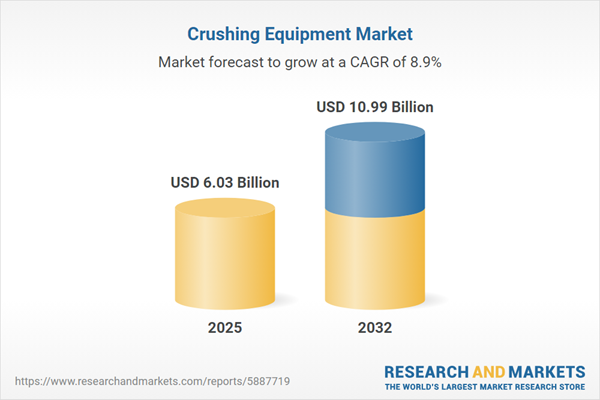Speak directly to the analyst to clarify any post sales queries you may have.
Senior decision-makers in the crushing equipment market are navigating an era defined by digital transformation, shifting compliance standards, and increased attention to sustainability. Informed, sector-specific intelligence is now essential for optimizing operational and strategic choices.
Market Snapshot: Crushing Equipment Market Size and Growth Outlook
The crushing equipment market is entering a period of robust expansion, with revenues forecast to rise from USD 5.55 billion in 2024 to USD 6.03 billion in 2025 and projected to reach USD 10.99 billion by 2032. This significant growth trajectory, supported by a compound annual growth rate (CAGR) of 8.92%, reflects the impact of major infrastructure investments, accelerating product innovation, and tightening regulatory policies.
As a result, leading industry players are adopting adaptive technologies and integrated systems. These investments are designed to reduce operational inefficiencies and align product portfolios with global compliance and sustainability requirements across diverse regions.Scope & Segmentation: Core Segments in the Crushing Equipment Market
This report delivers a targeted overview for senior leadership, presenting actionable segmentation to inform strategy, risk mitigation, and resource allocation. Each segment shapes market opportunity by addressing sector-specific requirements and operational risks:
- Crusher Type: Cone, gyratory, impact, and jaw crushers are deployed to meet distinct material handling needs, allowing companies to optimize throughput, minimize maintenance, and enhance durability within various industrial workflows.
- Mobility Type: Stationary, mobile, and portable systems facilitate deployment flexibility. These options match operational demands from established factory lines to projects that require rapid setup and relocation.
- Crushing Stage: Primary, secondary, and tertiary crushers address the full spectrum of application phases in mining, construction, and recycling, supporting efficient resource utilization.
- End-User Industry: Equipment solutions are customized for construction, mining, quarrying, and recycling, with a focus on integrating sector-specific production goals and advancing sustainability performance.
- Geographic Regions: North America, Latin America, Europe, Middle East, Africa, and Asia-Pacific each exhibit unique technology adoption rates and regulatory frameworks, influencing regional investment decisions.
- Leading Companies: Firms like Metso Outotec Corporation, Sandvik AB, ThyssenKrupp AG, FLSmidth & Co. A/S, Terex Corporation, The Weir Group PLC, Epiroc AB, Astec Industries, McLanahan Corporation, and Pilot Crushtec International (Pty) Ltd showcase different approaches to growth, sustainability integration, and strategic partnerships.
This comprehensive segmentation enables stakeholders to tailor strategies, streamline regulatory management, and target resources based on regional, technological, and operational criteria.
Key Takeaways: Strategic Insights for Senior Leaders
- Digital technologies such as advanced monitoring and analytics are enabling predictive maintenance, increased uptime, and better asset utilization.
- New business models, notably equipment-as-a-service, offer flexibility and allow organizations to swiftly adapt to variable project needs and changing customer expectations.
- Utilization of modular equipment design and regional supply chains enhances operational agility and supports compliance with evolving regulatory demands.
- Environmental, social, and governance (ESG) frameworks drive efficiency improvements and foster sustainable operating practices aligned with global standards.
- Compliance-oriented service agreements position companies to anticipate regulatory developments and ensure standardized operations across diverse jurisdictions.
Tariff Impact: United States Tariffs and Supply Chain Adaptation
Shifts in United States tariff regulations are prompting crushing equipment suppliers to reconfigure supply chains. Companies are responding by regionalizing assembly processes and deepening supplier partnerships to mitigate policy-related risks, stabilize operations, and uphold reliable delivery in a volatile regulatory context.
Methodology & Data Sources
This report leverages direct interviews with industry executives, in-person site evaluations, and confirmation from independent data sources. This triangulated approach guarantees relevant, actionable market insights for senior leaders navigating ongoing sector shifts.
Why This Report Matters: Benefits for Market Leaders
- Sets measurable standards for technology implementation and ESG integration, supporting compliance and sustainable growth in various markets.
- Delivers real-time market intelligence that empowers procurement and operations teams to manage supply chains effectively and pivot in response to new opportunities or disruptions.
- Promotes organizational adaptability and strengthens alignment with both current and emerging regulatory and business frameworks.
Conclusion
Access to precise, market-driven insights enables executive teams to address compliance and operational challenges, securing a firm position in the evolving crushing equipment industry.
Additional Product Information:
- Purchase of this report includes 1 year online access with quarterly updates.
- This report can be updated on request. Please contact our Customer Experience team using the Ask a Question widget on our website.
Table of Contents
3. Executive Summary
4. Market Overview
7. Cumulative Impact of Artificial Intelligence 2025
Companies Mentioned
The companies profiled in this Crushing Equipment market report include:- Metso Outotec Corporation
- Sandvik AB
- ThyssenKrupp AG
- FLSmidth & Co. A/S
- Terex Corporation
- The Weir Group PLC
- Epiroc AB
- Astec Industries, Inc.
- McLanahan Corporation
- Pilot Crushtec International (Pty) Ltd.
Table Information
| Report Attribute | Details |
|---|---|
| No. of Pages | 192 |
| Published | October 2025 |
| Forecast Period | 2025 - 2032 |
| Estimated Market Value ( USD | $ 6.03 Billion |
| Forecasted Market Value ( USD | $ 10.99 Billion |
| Compound Annual Growth Rate | 8.9% |
| Regions Covered | Global |
| No. of Companies Mentioned | 11 |









